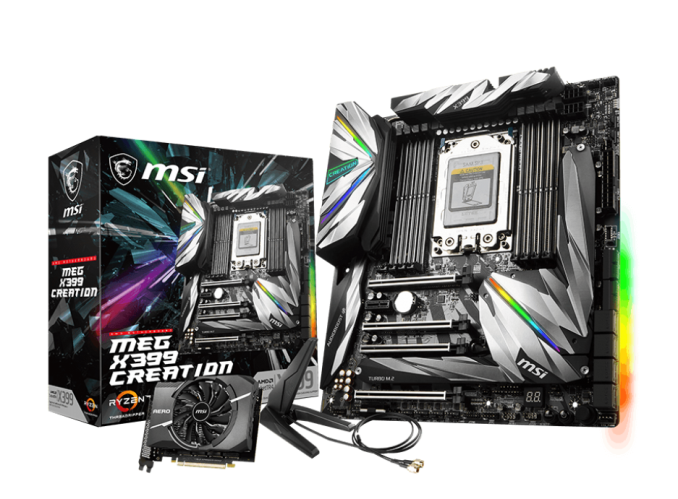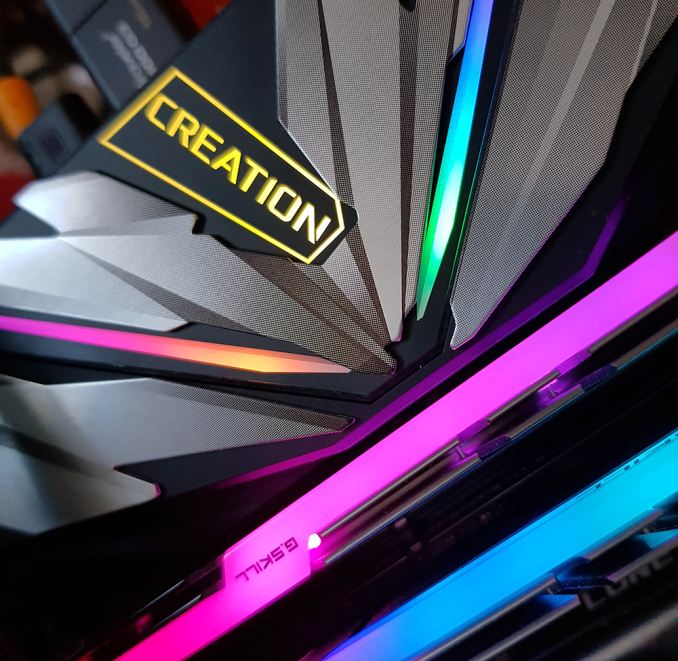The MSI MEG X399 Creation Motherboard Review: The New 16-Phase Shark In Town
by Gavin Bonshor on August 13, 2018 8:59 AM EST- Posted in
- Motherboards
- Gaming
- AMD
- MSI
- Overclocking
- ThreadRipper
- X399
- TR4
- Threadripper 2
MSI MEG X399 Creation Conclusion
The MSI MEG X399 Creation is a high-end motherboard in nearly every sense of the term. MSI has aimed the X399 Creation at content creators and designers, but there is also a clear and understated focus on gaming with elements of suitability for workstation purposes. The MEG X399 Creation is one of the most feature packed and expensive boards from MSI in a long time, and while they have gotten the majority of things right, there are some questionable decisions which do need to be highlighted and touched upon.
The design of the X399 MEG Creation is relatively unique, and although the PCB is black, it has a light grey imprinted patterning which resembles that of sun rays in its straightness emanating from the rear panel heatsink. The rear panel heatsink has the Creation logo etched in with an RGB LED underneath, which mirrors that of an explosion. RGB-wise the board has plenty going for it and has multiple zones as well as a total of three RGB strip headers, with one of them supporting addressable RGB strips. All of these are fully customizable by the comprehensive MSI Mystic Light software, which has to be one of the best around for variance with its umpteen lighting effects.
Other notable elements from a design perspective and storage support include the integrated MSI M.2 Frozr heatsink, which comes in two parts and offers the necessary cooling capacity to keep all three M.2 PCIe 3.0 x4 drives covered if a user so wishes. Two of the M.2 slots have support for up to M.2 2280 drives, while the third slot has support drives up to M.2 22100, with all slots also supporting SATA-based M.2 SSDs. The PCI layout consists of four full-length PCIe 3.0 x16 slots which all have a coating of MSI’s Steel Armor slot protection, and is complimented by a single PCIe 2.0 x1 slot for compatible expansion cards. As the board only supports up to three-way multi graphics card configurations, the fourth full-length slot would seem to be primarily intended for use with the included Xpander-Aero four-way M.2 PCIe expansion card, which in turn is cooled by a graphics card inspired cooler more than capable of dissipating heat from even the hottest of M.2 SSD arrays. The MSI MEG X399 Creation also has eight SATA ports with support for RAID 0, 1, and 10 arrays.
Performance-wise, the X399 Creation does a good job and remains consistent for the most part against the other X399 boards that we have reviewed. But in our system-based performance tests the overall consensus wasn't great, as we had some poor results with system boot times and DPC latency (though none of the X399 boards do especially well here). Otherwise CPU performance was consistent with performance within our DigiCortex neuron simulation benchmark coming in at the highest; a logical consequence of a switch in memory in our X399 test bench.
On paper, the power delivery system is considerably powerful and formidable, exactly what we'd expect for a board demanding a cost of $500. The 19-phase power delivery is split into two sections, 16 for the CPU and 3 for the memory, all of which consist of the Infineon TDA 21472 power stages. Each phase has a dedicated choke and while the CPU section has 16 power stages, the PWM controller is actually running at 8+0, as doublers are being used. Meanwhile each of the memory phases has its own dedicated driver, individual choke and benefits from its own dedicated controller running in a 3+0 configuration. Along those lines, the heatsink integrated onto the power delivery seems more than capable and I don't anticipate there being any issues with any of the current Ryzen Treadripper or new Threadripper 2 processors. The end result then is that overclocking is something this board does quite well, and users looking to run this on sub-zero cooling methods will appreciate the dual 8-pin CPU inputs, which processors such as the new Ryzen Threadripper 2990WX may need when overclocked under load.
Rear panel-wise, the MSI MEG X399 boasts a total of ten USB 3.1 ports, with a Gen 2 Type-C port, a Gen 2 Type-A port, and eight Gen1 Type-A ports. The regularly used Realtek ALC 1220 audio codec powers the five 3.5mm gold plated audio jacks and the single S/PDIF optical output, as well as supporting cases featuring front panel audio capabilities through an internal header.
In terms of networking, MSI has gone with a more premium Intel 9620 Wave 2 capable 802.11ac Wi-Fi card. But they seem to have dropped the ball when it comes to wired networking capability. The X399 Creation does have two LAN ports available – powered by Intel I211-AT Gigabit controllers – but the use of "just" Gigabit controllers is an odd choice. With a focus on professionals and content creators, the MEG X399 Creation should be including 10 GigE ports, especially given the $500 price tag commanded by MSI. Even the ASRock X470 Taichi Ultimate for $200 less managed to include one, and as a result I feel this to be a massive oversight on behalf of MSI here, especially given the benefits this would give to workstation users with 10G internet capabilities. But on the up side at least, there are plenty of PCIe slots and bandwidth to support 10GigE add-in cards.
Overall MSI has done a great job with the MEG X399 Creation, thanks to a mixture of good design choices such as the numerous 4-pin fan headers and the heatsink-covered M.2 slots. The aesthetics are unique and the creative explosion-inspired look with more RGB than you can shake a stick at makes this a desirable offering. However I still believe the lack of 10G LAN to be a massive hindrance on a board which prides itself on being a flagship, especially one priced to match. If MSI had put a little more thought into how they configured the board – favoring premium integrated features over exorbitant add-ons such as the Xpander-Aero M.2 PCIe card – then the MEG X399 Creation could have been the new X399 flagship motherboard that it so much deserved to be.












17 Comments
View All Comments
Chaitanya - Monday, August 13, 2018 - link
Even on high end there are no proper heatsinks for vrms its that silly solid chunks of aluminium with minimal fin stack that dominates. It was refreshing to see Gigabyte go back to old school finned heatsinks for their X470 board.Questor - Monday, August 13, 2018 - link
Flash over substance. It's a pitiful way to make a product.Oxford Guy - Wednesday, August 15, 2018 - link
Not to mention it looks worse than aluminum or copper fins.Oxford Guy - Wednesday, August 15, 2018 - link
ASUS and Gigabyte released VRM coolers back in 2013 that would be used with water systems as well as air (hybrids). This was for quad core non-prosumer CPUs, too. But, we have certainly progressed as an industry. Now, we can have really cool paint and LEDs instead of efficient VRM cooling.Questor - Monday, August 13, 2018 - link
Hopefully Buildzoid will get a hold of this model motherboard and verify it is what MSI says it is. I'm so tired of marketing lying about computer components, I don't believe much of what I read from the makers. Thus I am in "prove it" mode. Unfortunately, most reviewers either don't look or don't know what they see if they do.Ian Cutress - Monday, August 13, 2018 - link
This is one of the reasons we have our power delivery component table in our reviews now. Gavin knows what he's talking about - he did a good deconstruction of the B450 boards that exhibit the behaviour you are describing.https://www.anandtech.com/show/13085/the-asrock-b4...
Gothmoth - Monday, August 13, 2018 - link
it´s an 8 phase. as 2 "phases" are always in phase and therfore can not count as two seperate phases.one is marekting the other is reality.
diehardmacfan - Monday, August 13, 2018 - link
mmm no this looks like an actual 16 phase, just a "dumb" 16 phase because of the doublers.the cooling looks pretty crappy though.
KateH - Sunday, August 19, 2018 - link
i looked up the datasheet for the doublers mentioned and it describes them as outputting 2 PWM signals 180* apart so functionally its rectifying 16 phases, but the regulator sees 8.KateH - Sunday, August 19, 2018 - link
the datasheet if anyone is interested:https://www.infineon.com/dgdl/ir3599.pdf?fileId=55...
neat trick, and according to the sheet the doublers can also function as quadruplers so if one wanted 32 phases for some insane reason they could do that with the 8-channel controllers